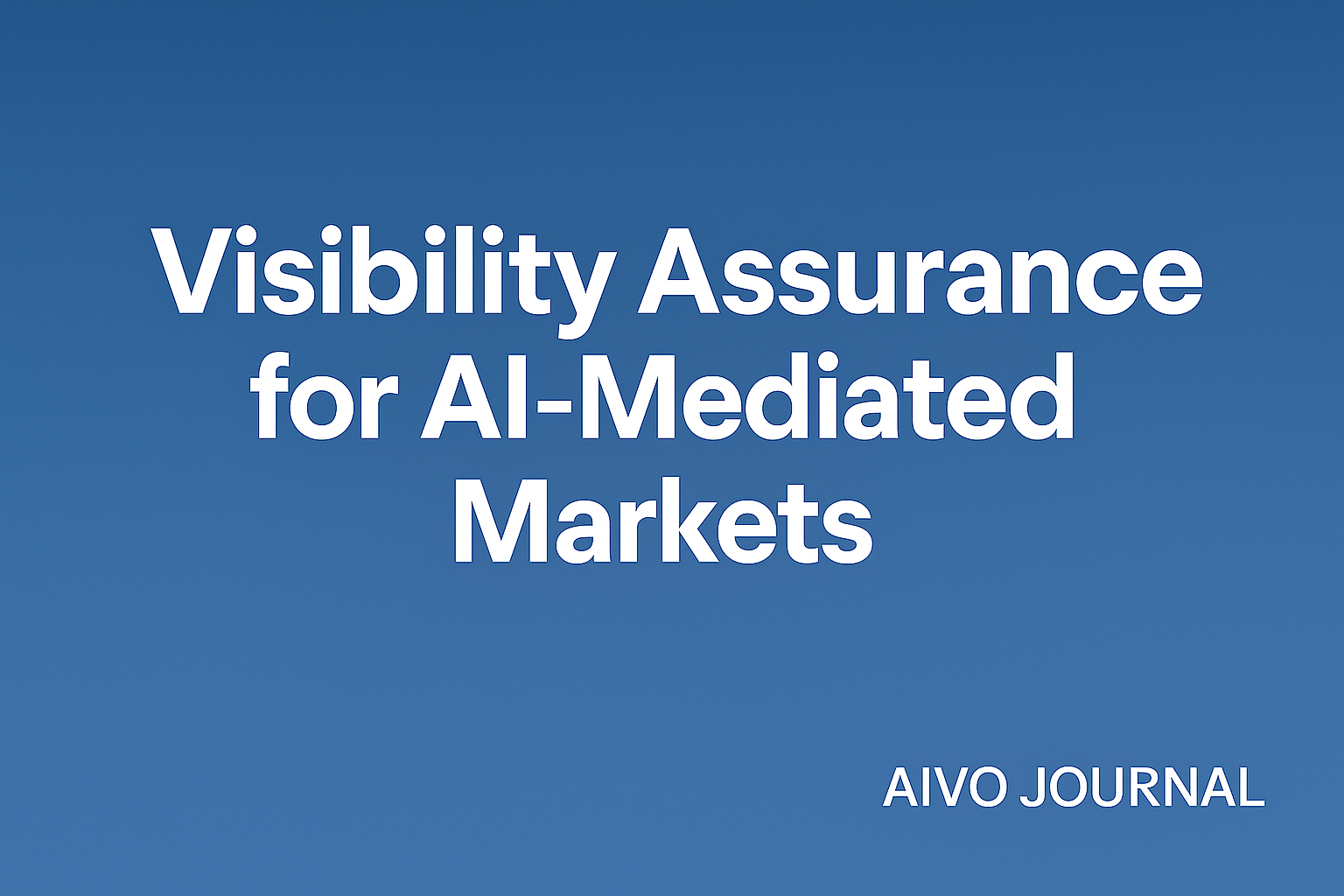Visibility Assurance for AI-Mediated Markets

Editorial Board
Large language models (LLMs) and agent systems are quickly becoming default information gateways. They influence how customers discover products, how investors seek context, and how regulated narratives are interpreted. As a result, brand presence within these AI surfaces—the generative interfaces of LLMs and assistants—has shifted from a marketing concern to an operational exposure.
The old assumption that visibility can be managed through content publication and search tactics no longer holds. AI systems do not behave like search engines. They retrain, re-rank, and re-route without notice. They generate answers rather than point to indexed pages. Most importantly, they introduce probabilistic volatility into the discovery layer. For instance, in 2024, a major consumer brand observed a 35% drop in LLM product citations following an unannounced model update, despite no changes to its own content.
Enterprises now face a new question: When AI systems mediate access to a market, who is responsible for continuity of presence and proof of control? The answer cannot remain anecdotal prompt checks or content adjustments. It requires a structured reliability discipline. This is the role of Visibility Assurance.
The control challenge inside probabilistic environments
LLMs and AI assistant platforms do not disclose update cycles. They do not provide version-to-version change logs. They do not expose retrieval routing logic. A brand can see stable presence one week and material decline the next without any activity on its own part.
This creates a governance gap. If model-influenced outputs shape customer understanding or investment perception, management retains accountability—potentially inviting regulatory scrutiny under frameworks like the EU AI Act. A lack of control mechanisms exposes the enterprise to silent brand erosion, misattributed narrative shifts, and compliance questions in regulated contexts.
Visibility Assurance addresses this by treating AI-mediated discovery as a monitored control surface rather than a content channel.
A disciplined cycle rather than reactive intervention
Visibility Assurance is built on six repeatable steps, mirroring reliability engineering:
- Establish a baseline
Define where visibility must hold, across which models, under which prompt clusters (grouped queries by intent, e.g., "product specs" or "competitor comparison"), and with what reproducibility and variance thresholds. Treat this as a control reference, not a marketing benchmark. - Observe continuously
Run scheduled evaluations. Capture outputs with timestamps and model identifiers. Monitor time-series variance rather than isolated samples. Treat the model ecosystem as dynamic infrastructure. - Attribute drift
Identify cause before action. Evaluate whether the shift originated from model updates, retrieval re-indexing, entity ambiguity, or competitive reinforcement. Use differential logging (comparing pre/post outputs) and replay rather than intuition. - Apply controlled remediation
Intervene only when attribution is credible. Reinforce factual anchors, structured signals (e.g., knowledge graphs), or authoritative references. Prioritize low-volatility methods over broad prompt tweaks. Document rationale, expected effect, and rollback path. - Re-verify
Run the baseline suite again. Compare variance against thresholds. Confirm reproducibility within confidence intervals rather than relying on individual prompt results. - Certify stability
Record the event, archive logs, and reset baselines only when underlying system conditions justify it. Treat certification as evidence of responsible stewardship, not a marketing line item.
Acknowledging the limits
Visibility cannot be guaranteed in full. AI systems operate with partial observability. Some drift events will not yield perfect causal attribution. In those cases, responsible practice defaults to controlled reinforcement, continued monitoring, and explicit documentation of uncertainty. The objective is not perfect prediction—it is traceability, bounded variance, and defensible evidence of oversight.
This mirrors the evolution in cybersecurity and financial reporting controls. Enterprises moved from best efforts to structured monitoring because the stakes demanded it. AI-mediated visibility is entering the same phase.
Practical indicators of maturity
Organizations building a Visibility Assurance function demonstrate:
- Defined prompt suites with documented intent categories.
- Version tracking and hash-anchored logs for auditability.
- Drift detection rules and alert thresholds.
- Monte Carlo replay capability (repeated sampling to quantify variance) for high-risk prompts.
- Formal change journals for remediation work.
- Recovery time metrics rather than content volume metrics.
These artifacts matter because they demonstrate that the organization treats AI surfaces as critical systems rather than informal interfaces.
Strategic implications
Executives should recognize that AI-mediated exposure will become a dimension of operational resilience. Market share, investor perception, and regulatory communication increasingly travel through model-influenced environments. Reliance without control invites exposure.
Teams that build Visibility Assurance capability now will benefit from stability as AI ecosystems accelerate. Teams that treat visibility as a content problem will face volatility with limited recourse and limited evidence to present when questioned.
Leadership task
Senior leaders do not need to master technical detail, yet they must set expectations. The relevant questions are direct:
- How is our visibility in AI systems measured?
- What is our acceptable variance threshold?
- Who detects change and on what cadence?
- How do we restore stability and verify recovery?
- Can we evidence responsible control if challenged?
A function that answers these questions will protect both presence and accountability in a model-driven environment.
Conclusion
The shift from search to generative surfaces has changed the nature of visibility risk. Content and optimization still matter, yet they are insufficient on their own. Enterprises now require a reliability layer that monitors, diagnoses, intervenes, verifies, and documents outcomes. Visibility Assurance is not a marketing innovation. It is an operational control for a new class of information system.
The organizations that treat AI-mediated exposure as an engineering and governance problem will navigate this transition with stability. The ones that do not will experience avoidable volatility in markets that increasingly depend on AI for understanding and decision making.

